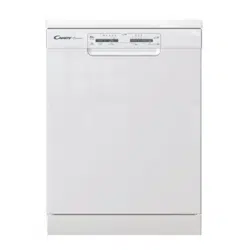Documents: Go to download!
User Manual
- User Manual - (English)
- Specification - (English)
- Quick operation guide
- Operation Instruction
- Prior using for the first time
- Loading the Dishwasher Baskets
- Starting a washing program
- Maintenance and Cleaning
- Troubleshooting Tips
Table of contents
Instruction Manual Dishwasher
Quick operation guide
For detailed operating method read the corresponding content on the instruction manual.
- Switch on the appliance: Open the door,press the On/Off button to switch on the appliance .
- Fill the detergent dispenser: The detergent container is inside the door. If the lid of the container is closed, press the button (A) to open. At the end of every wash cycle the lid is always open and ready for the next time the dishwasher is used.
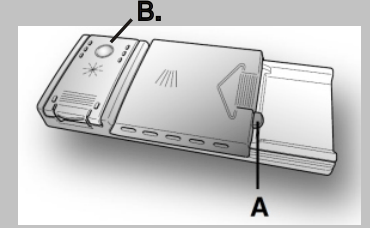
- Check the rinse aid level: Mechanical indicator B. It is always advisable to use rinse aid that is specifically designed for dishwasher. Check the rinse aid level through the indicator eye (B) which is located on the dispenser.
- Check the regeneration salt level: (On models with water softener system only.) Electric indicator on control panel (if provided). If there is no salt warning light in the control panel (for some models), you can estimate when to fill the salt into the softener by the number of cycles the dishwasher has run.
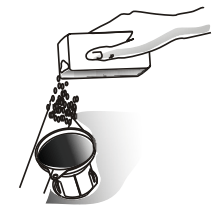
- Load the baskets: Scrape off any large amount of leftover food. Soften remnants of burnt food in pans, then load the baskets. Refer to the dishwasher loading instructions.
- Select a programme: Press the Programme Button until the selected programme lights up. ( See the section entitled Operation instruction )
- Running the dishwasher: Turn on the water tap ,close the door . The machine will start working after about 1 seconds.
- Changing the programme:
- A running cycle can only be modified if it has been running for a short time. Otherwise the detergent may have already been released and the water already drained. If this is the case, the detergent dispenser must be refilled.
- Open the door.
- Press the Programme Button for more than 3 seconds to cancel the running programme.
- Select a new programme.
- Restart the dishwasher.
- Add forgotten dishes in the dishwasher.
- Open the door a little to stop the dishwasher.
- After the spray arms stop working, you can open the door completely.
- Add the forgotten dishes.
- Close the door, the dishwasher will start running again after 10 seconds
- If the appliance is switched off during a wash cycle: If the appliance is switched off during a wash cycle, when switched on again, please re-select the washing cycle and operate the dishwasher according to the original Power-on state ).
- Changing the programme:
- Switch off the appliance: When the working cycle has finished, the buzzer of the dishwasher will sound 8 times, then stop. Turn off the appliance using the ON/OFF button. Since the appliance is standing by, it will power off automaticly after 30 minutes without any operation
- Turn off the water tap, unload the baskets: Warning: wait a few minutes (about 15 minutes) before unloading the dishwasher to avoid handling the dishes and utensils while they are still hot and more susceptible to break. They will also dry better. Unload the appliance, starting from the lower basket.
Operation Instruction
IMPORTANT: To get the best performance from your dishwasher, read all operating instructions before using it for the first time.
Control Panel

- On/Off Button: To turn on/off the power supply.
- Delay Button: To Press the button to delay.
- Power indicator: To show when the power on.
- Delay indicators: to show the delay time (3h/6h/9h/12h )
- Salt and rinse aid warning lights: To show when the salt container or dispenser need to be refilled
- Program indicators: to show which program you have chose;
- Haft load indicator: To show when you select the haft load function .
- Half load functions Button: To select Half load functions. (With this Half load function you can only use it when you have only about or less than 6 place setting dish wave, and you will see less water and energy consumption, can only be used with Intensive. Normal, ECO, Glass and 90 min.)
- Program Button: To Press the button to select a wash Program.
Dishwasher Features
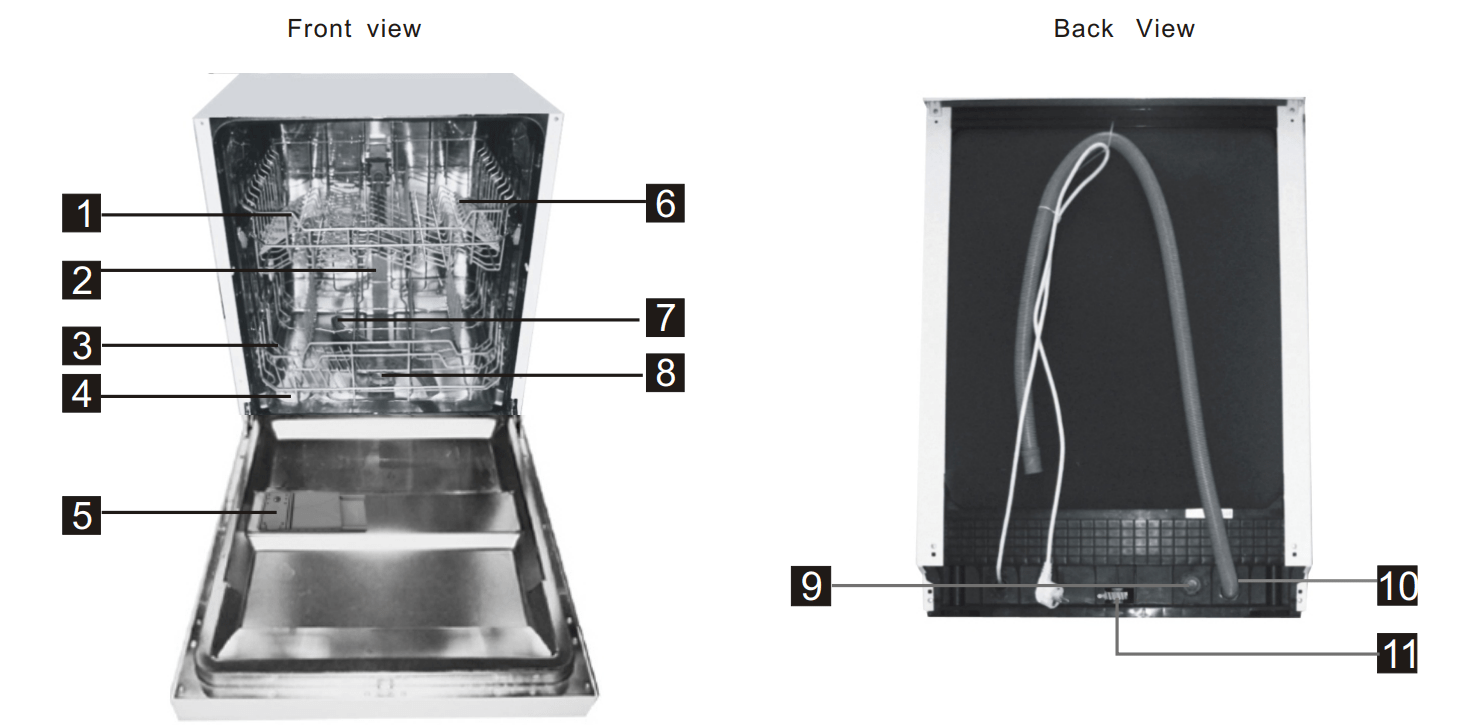
- Upper Basket
- Inner pipe
- Lower Basket
- Salt Container
- Dispenser
- Cup Shelf
- Spray arms
- Filter assembly
- Inlet pipe connector
- Drain pipe
- Adjuster
Prior using for the first time
Before using your dishwasher for the first time:
- A. Set the water softener
- B. Add 1.5Kg dishwasher salt and then full fill the salt container with water
- C. Fill the rinse aid dispenser
- D. Fill in detergent
A. Water Softener
- The water softener must be set manually, using the water hardness dial.
- The water softener is designed to remove minerals and salts from the water, which would have a detrimental or adverse effect on the operation of the appliance.
- The higher the content of these minerals and salts, the harder your water is.
- The softener should be adjusted according to the hardness of the water in your area. Your local Water Authority can advise you on the hardness of the water in your area.
Adjusting Salt Consumption
The dishwasher is designed to allow for adjustment in the amount of salt consumed based on the hardness of the water used. This is intended to optimise and customise the level o f salt consumption.
Please follow the steps below for adjustment in salt consumption.
- Open the door,Switch on the appliance;
- Press the Program button for more than 5 seconds to start the water softener set model within 60seconds after the appliance was switched on( The Salt and Rinse aid warning lights will be on periodically when it get in the set model );
- Press the Program button to select the proper set according to your local environment, the sets will change in the following sequence: H1->H2->H3->H4->H5->H6;
- Press the Power button to end the set up model.

B. Loading the Salt Into the Softener
Always use the salt intended for use with dishwasher. The salt container is located beneath the lower basket and should be filled as explained in the following:
Attention!
- Only use salt specifically designed for the use in dishwashers! Every other type of salt not specifically designed for the use in a dishwasher, especially table salt, will damage the water softener. In case of damages caused by the use of unsuitable salt the manufacturer does not give any warranty nor is liable for any damages caused.
- Only fill with salt just before starting one of the complete washing programs. This will prevent any grains of salt or salty water, which may have been spilled, remaining on the bottom of the machine for any period of time, which may cause corrosion.
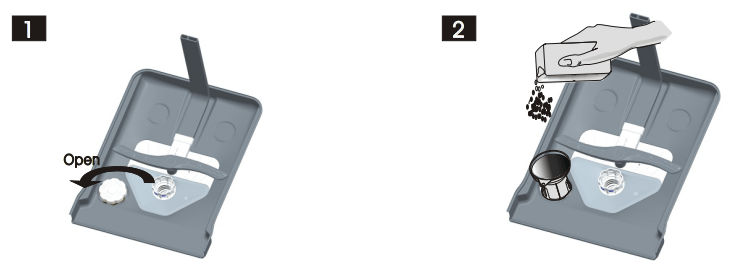
- A. After the lower basket has been removed, unscrew and remove the cap from the salt container.

- B. Place the end of the funnel (supplied) into the hole and introduce about 1.5kg of dishwasher salt
- C. Full fill the salt container with water,It is normal for a small amount of water to come out of the salt container.

- D. After filling the container , screw the cap tightly back clockwise.
- E. The salt warning light will stop being after the salt container has been filled with salt.
- F. Immediately after filling the salt into the salt container, a washing program should be started (We suggest to use a short program). Otherwise the filter system, pump or other important parts of the machine may be damaged by salty water. This is out of warranty.
C. LOADING THE DETERGENT
The detergent
- IMPORTANT: It is essential to use a detergent that is specifically designed for dishwashers either in powder, liquid or tablet form. FINISH gives very good results and can be easily obtained.Unsuitable detergents (like those for washing up by hand) do not contain the proper ingredients for use in a dishwasher and stop the dishwasher from working correctly.
Filling the detergent container
- The detergent container is inside the door (fig. A 2 ). If the lid of the container is closed, press the button (A) to open. At the end of every wash cycle the lid is always open and ready for the next time the dishwasher is used.
- The amount of detergent to be used varies according to how dirty the dishes are and on the type of dishes to be washed. We advise using 20/30 g of detergent in the wash section of detergent compartment (B).

- After pouring the detergent into the container,close the lid, firstly pushing (1) and then pressing on it (2) until you hear the click.
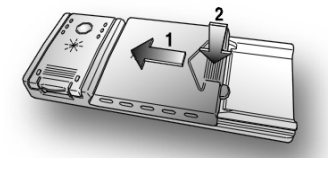
- Since not all detergents are the same the instructions on the boxes of detergent can vary. We should just like to remind users that too little detergent does not clean the dishes properly whilst too much detergent will not produce better results and is also a waste.
D. TYPES OF DETERGENT
Detergent tablets
- Detergent tablets of different manufacturers dissolve at different speeds, for this reason. during short programmes, some detergent tablets may be not fully effective, ecause they are not completely dissolved. If these products are used, is recommended to choose longer programmes to guarantee the complete use of the detergent.
IMPORTANT: To get satisfactory washing results, the tablets MUST be placed in the wash section of the detergent container and NOT directly in the tub.
Concentrated detergents
- The concentrated detergents. with reduced alkalinity and with natural enzymes. in conjunction with 50° wash programmes. have a smaller impact on the environment and they protect the dishes and the dishwasher. The 50° wash programmes purposely exploit the dirt-dissolving properties of the enzymes. allowing therefore, with the use of the concentrated detergents, to achieve the same results of the 65° programmes but at a lower temperature.
Combined detergents
- The detergents that also contain the rinse aid must be placed in the wash section of the detergent container. The rinse aid container must be empty (if it is not empty, set the rinse aid regulator to lowest position before using combined detergents).
“ALL in 1" combined detergents
If you are planning touse “ALLin 1” (“3in1" /“4in1” /“5in1”, etc.) combined detergents i.e.those with built in salt and/or rinse agent, we would advise the following:
- read carefully and follow the manufacturer's instructions given on the packaging;
- the effectiveness of detergents containing the built in water softener/salt depends on the hardness of your water supply. Check that the hardness of your water supply is within the effective range given on the detergent packaging
If when using this type of product, you don't get satisfactory washing results, please con manufacturer, tact the detergent
In certain circumstances use of combined detergents can cause
- limescale deposits on dishes or in the dishwasher;
- a reduction in washing and drying performance.
IMPORTANT: Any problems which arise as a direct result of the use of these products are not covered by our warranty.
Please note that using the "ALL in "combined detergents, the rinse aid and salt indicator lights (only used on selected models) are superfluous, so you must ignore the lights
If washing and/or drying problems occur, we recommend you return to use traditional separate products (salt, detergent and rinse agent). This will ensure that the water softener in the dishwasher operates correctly.
In this case, we recommends that you:
- refill both the salt and rinse aid container;
- run one normal washing cycle without a load
Please note that on return to the use of conventional salt, a number of cycles will be required before the system becomes fully efficient again.
LOADING THE RINSE AID
The rinse aid
- The rinse aid, which is automatically released during the last rinsing cycle, helps the dishes to dry quickly and prevents spots and stains forming.
Filling the rinse aid container
- The rinse aid container can be found to the left of the detergent container (fig. A "3").To open the lid, push the reference mark and, in the same time, pull the tab of opening.It is always advisable to use rinse aid that is specifically designed for dishwasher.Check the rinse aid level through the indicator eye (C) which is located on the dispenser
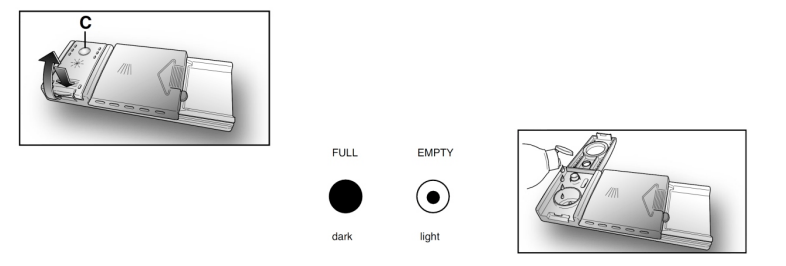
Regulating the rinse aid from 1 to 6
- The regulator (D) is placed under the lid and can be turned using a coin.The recommended position is 4.The limestone content of the water considerably affects the formation of limescale and the drying performance. It is therefore important to regulate the quantity of rinse aid to achieve good washing results.If, after the wash, streaks occur on the dishes, decrease the amount by one position. If whitish spots occur, increase the amount by one position.
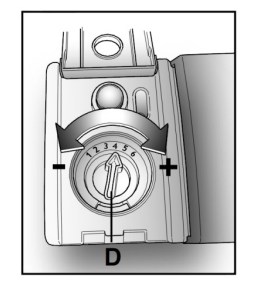
Loading the Dishwasher Baskets
Recommendation
- Consider buying utensils which are identified as dishwasher-proof.
- Use a mild detergent that is described as 'kind to dishes'. If necessary, seek further information from the detergent manufacturers.
- For particular items, select a program with as low a temperature as possible.
- To prevent damage, do not take glass and cutlery out of the dishwasher immediately after the programme has ended.
For washing in the dishwasher the following cutlery/dishes
Are not suitable
- Cutlery with wooden, horn china or mother-of-pearl handles
- Plastic items that are not heat resistant
- Older cutlery with glued parts that are not temperature resistant
- Bonded cutlery items or dishes
- Pewter or cooper items
- Crystal glass
- Steel items subject to rusting
- Wooden platters
- Items made from synthetic fibres
Are of limited suitability
- Some types of glasses can become dull after a large number of washes
- Silver and aluminum parts have a tendency to discolour during washing
- Glazed patterns may fade if machine washed frequently
Attention before or after loading the Dishwasher Baskets
(For best performance of the dishwasher, follow these loading guidelines. Features and appearance of baskets and cutlery baskets may vary from your model.)
Scrape off any large amounts of leftover food. Soften remnants of burnt food in pans. It is not necessary to rinse the dishes under running water. Place objects in the dishwasher in following way:
- Items such as cups, glasses, pots/pans, etc. are faced downwards.
- Curved items, or ones with recesses, should be loaded aslant so that water can run off.
- All utensils are stacked securely and can not tip over.
- All utensils are placed in the way that the spray arms can rotate freely during washing.
NOTE: Very small items should not be washed in the dishwasher as they could easily fall out of the basket.
- Load hollow items such as cups, glasses, pans etc. With the opening facing downwards so that water cannot collect in the container or a deep base.
- Dishes and items of cutlery must not lie inside one another, or cover each other.
- To avoid damage to glasses, they must not touch.
- Load large items which are most difficult to clean into the lower basket.
- The upper basket is designed to hold more delicate and lighter dishware such as glasses, coffee and tea cups
- Long bladed knives stored in an upright position are a potential hazard!
- Long and/or sharp items of cutlery such as carving knives must be positioned horizontally in the upper basket.
- Please do not overload your dishwasher. This is important for good results and for reasonable consumption of energy.
Removing the Dishes
- To prevent water dripping from the upper basket into the lower basket, we recommend that you empty the lower basket first and then the upper basket.
The Method Loading Normal Dishware
Loading the Upper Basket
- The upper basket is designed to hold more delicate and lighter dishware such as glasses, coffee and tea cups and saucers, as well as plates, small bowls and shallow pans (as long as they are not too dirty). Position the dishes and cookware so that they will not get moved by the spray of water.
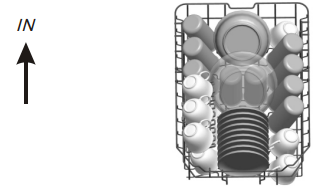
Please be reminded that:
- Pots, serving bowls, etc, must always be placed top down.
- Deep pots should be slanted to allow water to flow out
- The Bottom Basket features folding spikes so that larger or more pots and pans can be loaded
Loading the Lower Basket
- We suggest that you place large items and the most difficult to clean items are to be placed into the lower basket: such as pots, pans, lids, serving dishes and bowls, as shown in the figure below. It is preferable to place serving dishes and lids on the side of the racks in order to avoid blocking the rotation of the top spray arm.
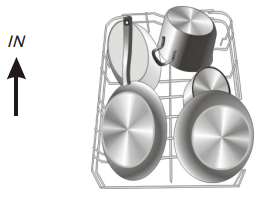
Adjusting the Upper Basket
- The height of the upper basket can be adjusted in order to create more space for large utensils both for the upper /lower basket. The height of the upper basket can be adjusted by placing the wheels on different height of the rails. Long items, serving cutlery, salad servers and knives should be placed on the shelf so that they do not obstruct the rotation of the spray arms..
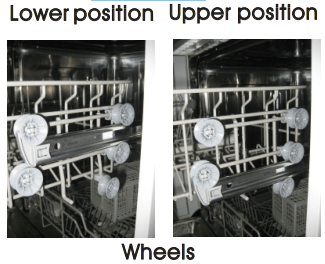
Folding back the cup shelives
- For better stacking of pots and pans, the spikes can be folded down as show in the picture right.
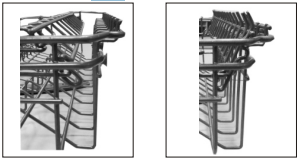
Folding Spikes of Lower Basket
- For better stacking of pots and pans, the spikes can be folded down as show in the picture right.

Cutlery Basket
- Cutlery should be placed in the cutlery basket with the handles at the bottom. If the rack has side baskets, the spoons should be loaded separately into the appropriate slots, especially long utensils should be placed in the horizontal position at the front of the upper basket as shown in the picture.

WARNING!:
- Do not let any item extend through the bottom.
- Always load sharp utensils with the sharp point down!
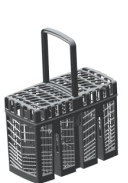
For personal safety and a top quality cleaning, place the silverware in the basket making sure that:
- They do not nest together.
- Silverware is placed with the handles-down.
- But place knives and other potentially dangerous utensils are placed handles-up.
Starting a washing program
Wash Cycle Table
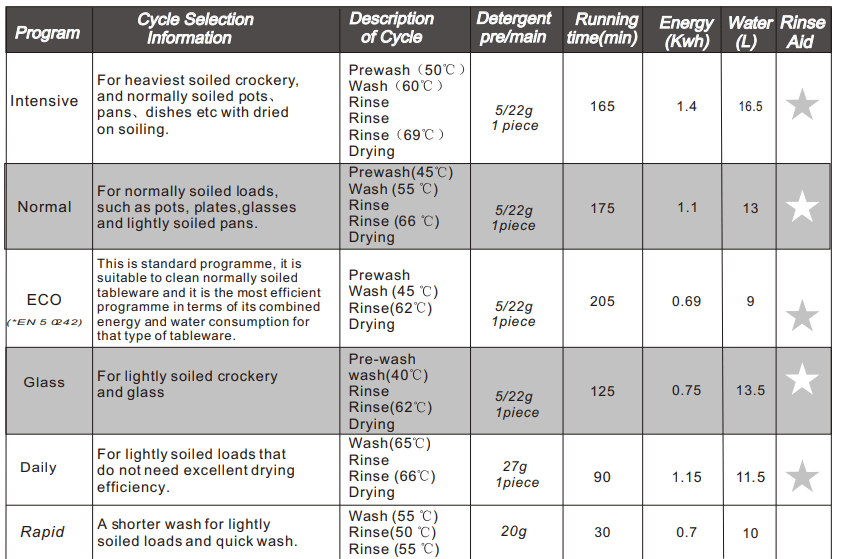
Turning On the Appliance
Starting a cycle wash
- Draw out the lower and upper basket, load the dishes and push them back. It is commended to load the lower basket first, then the upper one (see the section entitled Loading the Dishwasher ).
- Pour in the detergent (see the section entitled Salt, Detergent and Rinse Aid ).
- Insert the plug into the socket. The power supply is 220-240 VAC /50 HZ, the specification of the socket is 10A 250VAC. Make sure that the water supply is turned on to full pressure.
- Close the door, press the Power button, to switch on the machine.
- Press the program button , the wash program will be changed as follows direction: Intensive->Normal->ECO->Glass->Daily->Rapid; If a program is selected, the response light will light. Then press the Start/Pause button, the dishwasher begins to start.
Change the Program...
Premise:
- A cycle that is underway can only be modified if it has only been running for a short time. Otherwise, the detergent may have already been released, and the appliance may have already drained the wash water. If this is the case, the detergent dispenser must be refilled (see the section entitled " Loading the Detergent " ).
- Open the door ,press the Program button more than 3 seconds , the machine will be in standby state, then you can change the program to the desired cycle setting (see the section entitled " Starting a wash cycle. . ." ).
Forgot to Add a Dish?
A forgotten dish can be added any time before the detergent cup opens.
- Open the door a little .
- After the spray arms stop working, you can open the door completely
- Add forgotten dishes.
- Close the door
- The dishwasher will run after 1 seconds.
At the End of the Wash Cycle
When the working cycle has finished, the buzzer of the dishwasher will sound for 8 seconds, then stop. Turn off the appliance using the ON/OFF button, shut off the water supply and open the door of the dishwasher. Wait for a few minutes before unloading the dishwasher to avoid handling the dishes and utensils while they are still hot and more susceptible to breakage. They will also dry better.
- Switch Off the Dishwasher: The program light is on but is not blinking, only in this case the programme has ended.
- Open the door.Switch off the dishwasher by pressing the ON/OFF button.
- Turn off the water tap!
- Open the door carefully. Hot dishes are sensitive to knocks. The dishes should therefore be allowed to cool down around 15 minutes before removing from the appliance. Open the dishwasher's door, leave it ajar and wait a few minutes before removing the dishes. In this way they will be cooler and the drying will be improved.
- Unloading the dishwasher: It is normal that the dishwasher is wet inside. Empty the lower basket first and then the upper one. This will avoid water dripping from the upper Basket onto the dishes in the lower one.
Maintenance and Cleaning
Filtering System
- The filter prevents larger remnants of food or other objects from getting inside the pump. The residues may block the filter, in this case they must be removed.
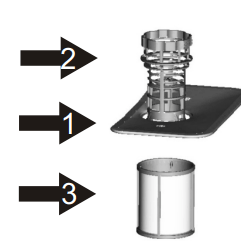
- The filter system consists of a coarse filter,a flat (Main filter) And a microfilter(Fine filter).
- Main filter

- Food and soil particles trapped in this filter are pulverized by a special jet on the lower spray arm and washed down to drain.
- Coarse filter

- Larger items, such as pieces of bones or glass, that could block the drain are trapped in the coarse filter. To remove the items caught by the filter, gently squeeze the tap on the top of this filter and lift out.
- Fine filter

- This filter holds soil and food residues in the sump area and prevents it from being redeposit on the dishes during wash cycle.
Filter assembly
- The filter efficiently removes food particles from the wash water, allowing it to be recycled during the cycle. For best performance and results, the filter must be cleaned regularly. For this reason, it is a good idea to remove the larger food particles trapped in the filter after each wash cycle by rinsing the semicircular filter and cup under running water. To remove the filter device, pull the cup handle in the upward direction.
WARNING: The dishwasher must never be used without the filters. Improper replacement of the filter may reduce the performance level of the appliance and damage dishes and utensils.

- Step 1: Turn the filter in anti-clockwise direction,
- Step 2: lift the filter assy up
NOTE: When following this procedure from step1 to step 2, the filter system will be removed; when following it from Step 2 to Step 1, the filter system will be installed.
Remarks:
- Inspect the filters for blocking after every time the dishwasher has been used.
- By unscrewing the coarse filter, you can remove the filter system. Remove any food remnants and clean the filters under running water.
NOTE: The entire filter assembly should be cleaned once a week.
Cleaning the Filter
- To clean the coarse filter and the fine filter, use a cleaning brush. Reassemble the filter parts as shown in the figures on the last page and reinsert the entire assembly in the dishwasher, positioning it in its seat and pressing downwards.
WARNING! When cleaning the filters, don't knock on them. Otherwise, the filters could be contorted and the performance of the dishwasher could be decreased.
Caring for the Dishwasher
The control panel can be cleaned by using a lightly dampened cloth.
After cleaning, make sure to dry it thoroughly.
For the exterior, use a good appliance polish wax.
Never use sharp objects, scouring pads or harsh cleaners on any part of the dishwasher.
Cleaning The Door

- To clean the edge around the door, you should use only a soft warm, damp cloth. To avoid penetration of water into the door lock and electrical components, do not use a spray cleaner of any kind.
WARNING! Never use a spray cleaner to clean the door panel as it may damage the door lock and electrical components. Abrasive agents or some paper towels should not be used because of the risk of scratching or leaving spots on the stainless steel surface.
Protect Against Freezing
please take frost protection measures on the dishwasher in winter. Every time after washing cycles, please operate as follows
- Cut off the electrical power to the dishwasher.
- Turn off the water supply and disconnect the water inlet pipe from the water valve.
- Drain the water from the inlet pipe and water valve. (Use a pan to gather the water)
- Reconnect the water inlet pipe to the water valve.
- Remove the filter at the bottom of the tub and use a sponge to soak up water in the sump.
NOTE: If your dishwasher cannot work because of the ice, please contact professional service persons.
Cleaning the Spray Arms
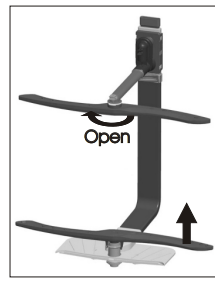
- It is necessary to clean the spray arms regularly for hard water chemicals will clog the spray arm jets and bearings.
- To remove the upper spray arm, hold the nut, rotate the arm clockwise to remove it.
- To remove the lower spray arm, pull out the spray arm upward.
- Wash the arms in soapy and warm water and use a soft brush to clean the jets. Replace them after rinsing them thoroughly.
How to Keep Your Dishwasher in Shape
- After Every Wash: After every wash, turn off the water supply to the appliance and leave the door slightly open so that moisture and odours are not trapped inside.
- Remove the Plug: Before cleaning or performing maintenance, always remove the plug from the socket.
- : No Solvents or Abrasive Cleaning: To clean the exterior and rubber parts of the dishwasher, do not use solvents or abrasive cleaning products. Only use a cloth with warm soapy water. To remove spots or stains from the surface of the interior, use a cloth dampened with water an a little vinegar, or a cleaning product made specifically for dishwashers.
- When not in Use for a LongTime: It is recommend that you run a wash cycle with the dishwasher empty and then remove the plug from the socket, turn off the water supply and leave the door of the appliance slightly open. This will help the door seals to last longer and prevent odours from forming within the appliance.
- Moving the Appliance: If the appliance must be moved, try to keep it in the vertical position. If absolutely necessary, it can be positioned on its back.
- Seals: One of the factors that cause odours to form in the dishwasher is food that remains trapped in the seals. Periodic cleaning with a damp sponge will prevent this from occurring
Troubleshooting Tips
Before Calling for Service
Review the charts on the following pages may save you from calling for service.
Problem | Possible | Causes | What To Do |
| Technical problems | Dishwasher doesn't start | Fuse blown, or the circuit breaker acted | Replace fuse or reset circuit breaker. Remove any other appliances sharing the same circuit with the dishwasher |
| Power supply is not turned on | Make sure the dishwasher is turned on and the door is closed securely. Make sure the power cord is properly plugged into the wall socket. | ||
| Water pressure is low | Check that the water supply is connected properly and the water is turned on. | ||
Door of dishwasher not properly closed. | Make sure to close the door properly and latch it. | ||
| water not pumped form dishwasher | Kink in drain hose | Check drain hose. | |
| Filter clogged | Check coarse the filter (see section titled " Cleaning The Filter ") | ||
| Kitchen sink clogged | Check the kitchen sink to make sure it is draining well. If the problem is the kitchen sink not draining ,you may need a plumber rather than a serviceman for dishwashers. | ||
General problems | Suds in the tub | Improper detergent | Use only the special dishwasher detergent to avoid suds. If this occurs, open the dishwasher and let suds evaporate. Add 1 gallon of cold water to the tub. Close and latch the dishwasher, then select any cycle. Dishwasher will drain out the water at the first step.Open the door after draining is stop and check if the suds is disappeared. Repeat if necessary. |
| Spilled rinse-aid | Always wipe up rinse-aid spills immediately. | ||
| Stained tub interior | Detergent with colourant was used | Make sure that the detergent is the one without colourant. | |
White film on inside surface | Hard water minerals | To clean the interior, use a damp sponge with dishwasher detergent and wear rubber gloves. Never use any other cleaner than dishwasher detergent for the risk of foaming or suds. | |
There are rust stains on cutlery | The affected items are not corrosion resistant. | ||
A programme was not run after dishwasher salt was added. Traces of salt have gotten into the wash cycle. | Always run the quick wash programme . without any crockery in the dishwasher and without selecting the Turbo function (if present), after adding dishwasher salt. | ||
The lid of the softer is loose | Check the lip .Ensure the fix is fine. | ||
Noise | Knocking noise in the wash cabinet | A spray arm is knocking against an item in a basket | Interrupt the programme, and rearrange the items which are obstructing the spray arm. |
Rattling noise in the wash cabinet | Items of crockery are loose in the wash cabinet | Interrupt the programme, and rearrange the items of crockery. | |
Knocking noise in the water pipes | This may be caused by on-site installation or the cross-section of the piping. | This has no influence on the dishwasher function. if in doubt, contact a suitably qualified plumber. | |
Unsatis -factory washing result | The dishes are not clean | The dishes were not loaded correctly. | See notes in " Loading the Dishwasher Baskets " |
| The programme was not powerful enough. | Select a more intensive programme. See" Wash Cycle Table ". | ||
Not enough detergent was dispensed. | Use more detergent, or change your detergent. | ||
Items are blocking the path of spray arms. | Rearrange the items so that the spray can rotate freely. | ||
The filter combination in the base of wash cabinet is not clean or is not correctly fitted. This may cause the spray arm jets to get blocked. | Clean and/or fit the filter combination correctly. Clean the spray arm jets. See "Cleaning the Spray Arms". | ||
Cloudiness on glassware | Combination of soft water and too much detergent. | Use less detergent if you have soft water and select a shortest cycle to wash the glassware and to get them clean. | |
Black or gray marks on dishes | Aluminum utensils have rubbed against dishes. | Use a mild abrasive cleaner to eliminate those marks. | |
| Detergent left in dispenser cups | Dishes block detergent cups. | Re-loading the dishes properly. | |
Unsatis -factory drying result | The dishes are not drying | Improper loading | Load the dishwasher as suggested in the directions. |
Too little rinse-aid | Increase the amount of rinse-aid/refill the rinse-aid dispenser. | ||
Dishes are removed too soon | Do not empty your dishwasher immediately after washing. Open the door slightly so that the steam can escape. Begin unloading the dishwasher only once t he dishes are barely warm to the touch. Empty the low basket first. This prevents water form dropping off dishes in the upper basket. | ||
Wrong program has been selected | In short program the washing temperature is lower. This also lowers cleaning performance. Choose a program with a long washing time. | ||
Use of cutlery with a low-quality coating | Water drainage is more difficult with these items. Cutlery or dishes of this type are not suitable for washing in the dishwasher. |
Error Codes
When some malfunctions come on, the appliance will display error codes to warn you:
Codes | Meanings | Possible Causes |
The Rapid light flicker fleetly | Longer inlet time. | Faucets is not opened, or water intake is restricted,or water pressure is too low. |
The Glass light flicker fleetly | Overflow. | Some element of dishwasher leaks . |
WARNING: If overflow occurs, turn off the main water supply before calling a service. If there is water in the base pan because of an overfill or small leak, the water should be removed before restarting the dishwasher.
See other models: 2L1049W-80 1LS57B-80 1DS39B-80 1LS67W-80 1LS57W-80
